Anatomy of the Horse
NOTE: This page may take a moment to load, because it contains diagrams. It
is worth the short wait, though!
Anatomy Facts
- Horses have about 175 bones
- A horse's leg joints are not fully fused (grown) until around the age
of 3 1/2.
- Most horse breeds have 18 ribs. The Arabian has 17.
- Most horses have 6 lumbar bones. The Arabian has 5.
- Most horses have 18 tail vertabrea. The Arabian has 16.
- Horses can see in two directions at once.
- Horses can see everywhere, except directly in front or behind them.
- Horses hooves grow at a rate of about 1 cm per month.
Outer Anatomy
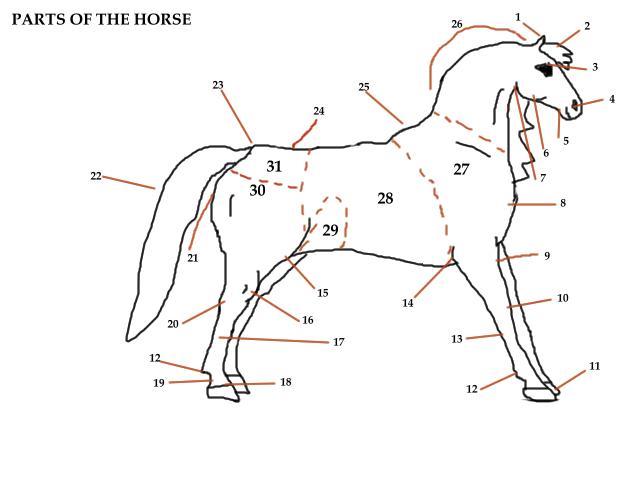
1. Ear 2. Forelock 3. Eye 4. Nostril
5. Chin Groove
6. Cheek 7. Throat Latch 8. Point of Chest
9. Forearm 10. Knee
11. Hooves 12. Fetlock Joint 13. Front Cannon
14. Point of Elbow 15. Stifle
16. Gaskin 17. Hind Cannon 18. Coronet Band
19. Pastern 20. Hock
21. Point of Buttock 22. Tail 23. Dock
24. Loins 25. Withers
26. Crest 27. Shoulder 28. Barrel
29. Flank 30. Hindquarters 31. Croup
The Hoof
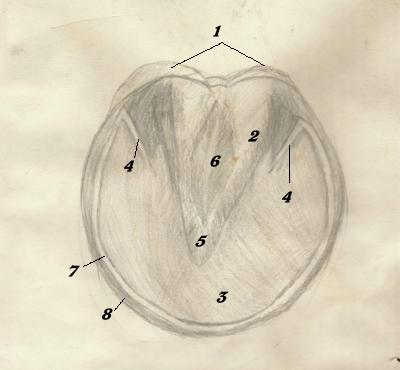
1. Bulbs of Heels 2. Frog 3.Sole of Hoof
4.Bars
5. Apex of Frog 6. Central Sulcus of Frog, or Lateral Furrow of
Frog
7. White Line 8. Hoof Wall
Inner Anatomy

1. The Skull 2. Mandible 3. Scalpula
4. Atlas
5. Axis 6. Scalpula Cartiliage 7.Vertabrae
8.Ilium
9. Femur 10. Hock Joint 11.Cannon Bone
12.Tibia 13. Stifle Joint
14. Ribs 15.Elbow 16.Pastern
17.Pedal, or Coffin bone, or Third Phalanx 18.Short Pastern, or
Second Phalanx 19. Long Pastern, or First Phalanx
20. Knee Joint 21. Radius 22. Elbow Joint
23. Humerous
The Legs
The Front Leg
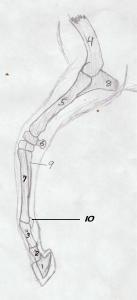
1. Coffin Bone, or Third Phalanx 2. Second Phalanx, or Small Pastern
3. Large Pastern, or First Phalanx 4. Humerus
5. Radius 6. Pisiform
7. Large Metacarpal 8. Trapizoid,or Ulna
9.Splint Bone 10. Sesamoid Bone
The Hind Leg
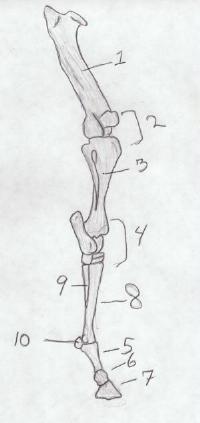
1. The Femur or Tarsus 2. The Stifle Joint 3. The
Tibia 4.Hock Joint
5. Long Pastern, or Third Phalanx 6. The short pastern, or Second
Phalanx 7. Pedal bone, Coffin Bone, or Third Phalanx
8. Cannon Bone 9. Splint Bone 10. Sesamoid
The Hock Joint
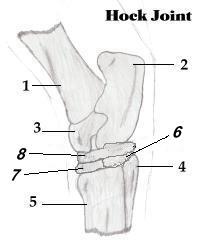
1. the tibia
2. fibular tarsal bone, or calcaneus
3. talus, or tibial tarsal bone.
4. splint bone
5. cannon bone
6. second tarsal (T2)
7. third tarsal (T3)
8. centeral tarsal (TC)
Fetlock Joint
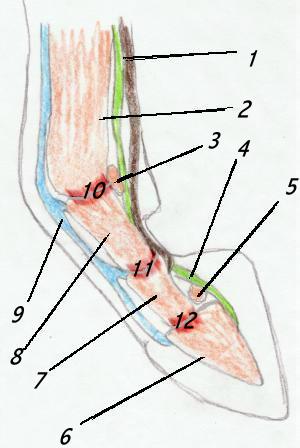
1. Superficial Digital Flexor Tendon
2. Cannon Bone
3. Sesamoid Bone
4. Deep Digital Flexor Tendon
5. Navicular Bone
6. Coffin Bone
7. Short Pastern, or 2nd Phalanx
8. Long Pastern, or 1st Phalanx
9. Digital Extensor Tendon
10. Fetlock Joint
11. Pastern Joint
12. Coffin Joint
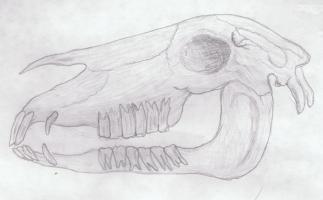
This is a horse's skull. The teeth near the front of the mouth are incisors.They
are used to chop grass and other food. The smooth place with no teeth is called
the bars. That is where the bit rest's in the horse's mouth. The two small,
sharp teeth are called canines, or tushes. All sexes can grow them, but it seems
that they are more common geldings and stallions than in mares. As long as they
do not grow to large or interfere with the bit, they are usualy fine. If they
do, then you can have your vet file them off. The teeth in the very back are
the molars. They are used to crush and grind the horse's food.
The Horse's Body
Horses today may vary greatly depending on breed, but they all resemble each
other. Here are some things that all horses have in common:
Stiff backs. A horse cannot move or bend its back, like we can. There backs
stay straight, making it easier to run and buck. But, it also makes it harder
for them to rise. That is partialy the reason why horse's don't lay down alot.
When they do, they must be careful of how they get up. First, the horse must
be laying down with all four legs beneath itself. Then it will quickly swing
its head and neck up, transfering the weight to its hind end. While it does
this, it must pull its front legs forward, moving into a sitting position. Then,
the horse will push its head and neck down, and pull itself up far enough to
get its hind legs straight. It will bring its hind legs up, and will be standing.
All of this happens relativly quickly, but it is still a bit difficult for the
horse.
Unique Legs and Feet. The horse's legs and feet are actually quite hardy. Since
horses are almost always standing, thier feet must be built to absorb shock
and handle weight. The frog of the hoof is a flexible but strong triangular
part of the hoof. When the horse's hoof lands, it absorbs the shock, cushioning
the leg. That is why horses can run, jump, and buck without hurting themselves.
The legs also have tendons and ligaments throughout them that are elastic enough
for the horse to flex, but tight enough to keep the leg from getting sprained.
But horses that are ridden on hard surfaces or horses that are worked hard still
need shoes.
Manes and Tails. Okay, that is sort of dumb to metion, but all horses do
have manes and tails! Why? . Tails are important for swishing off flies
and bugs. They are also used to commuticate with other horses. I think that
the reason horses have manes is sort of the same for tails. They blow in the
wind, and help to shoo the flies away. The forelock on the horse's forehead
helps keep bugs away from the horse's eyes.
Chestnuts. You know, those weird little scaly sort of thingies on the inside
of each horse's leg. As they grow they peel and fall off. Some people think
that these may be remains of more toes from when the horse was that little dog-sized
creature alot of years ago. If you smell these, you will find that they smell
strongly of horse. They are probably just scent glands that help horses
to remember other horses when they meet.







